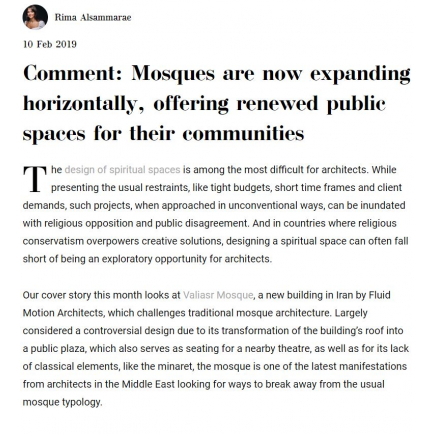
Mosques are now expanding horizontally, offering renewed public spaces for their communities
تاريخ الاضافة
10/07/2019
نوع المحتوى
Article
الرابط للمحتوى
الكاتب
Rima Alsammarae
الناشر
www.middleeastarchitect.com
Year of Publication
2019
الوصف
The design of spiritual spaces is
among the most difficult for architects. While presenting the usual restraints,
like tight budgets, short time frames and client demands, such projects, when
approached in unconventional ways, can be inundated with religious opposition
and public disagreement. And in countries where religious conservatism
overpowers creative solutions, designing a spiritual space can often fall short
of being an exploratory opportunity for architects.
Our cover story this month looks at Valiasr Mosque, a new
building in Iran by Fluid Motion Architects, which challenges traditional
mosque architecture. Largely considered a controversial design due to its
transformation of the building’s roof into a public plaza, which also serves as
seating for a nearby theatre, as well as for its lack of classical elements,
like the minaret, the mosque is one of the latest manifestations from
architects in the Middle East looking for ways to break away from the usual
mosque typology.
Other recent examples include Amir Shakib Arslan by L.E.FT Architects in Lebanon, Al Dana Mosque by X-Architects in
the UAE, and Sancaklar Mosque by Emre Arolat Architects in Turkey. Iranian architect Arash G Tehrani also
revealed a new concept proposal for a mosque in Golshahr, Alborz, which
integrates a plaza into its site, intending to offer a place for social
gathering. It proposes an interesting reinterpretation of the sacred space, and
reconnects the mosque to its urban context.
Such examples reflect the changing architectural language of mosques
simultaneously happening in different Muslim countries, illustrating their
horizontal expansion rather than vertical, as reflected in their incorporation
of plazas and landscaped areas. Rather than keeping
engagement with visitors an indoor activity, mosques are beginning to offer a
hospitable non-denominational space for respite to local community members.
Catherine Spiridonoff, CEO of Fluid Motion Architects, the firm behind our
cover story, discussed the reforming approach to mosque design, and drew
Valiasr’s design inspiration from Prophet Muhammad’s time. According to her,
the first mosques ever built refrained from vertical dominance, which she said
developed later over the centuries.
“After Prophet Muhammad, elements like the dome and minarets were added to the
architecture of the mosque,” she said. “The mosque’s peaceful horizontal form
transformed into a vertical shape as a symbol of authority.”
“Valiasr is a criticism of the vertical authoritarian structures of classical
mosques and proposes peace and equality,” she added.
While mosques have always been a private place of tranquility for believers,
their changing typology is a reflection of the desire to further integrate
mosques into their contexts and rethink their visual dialogue with
their communities.





